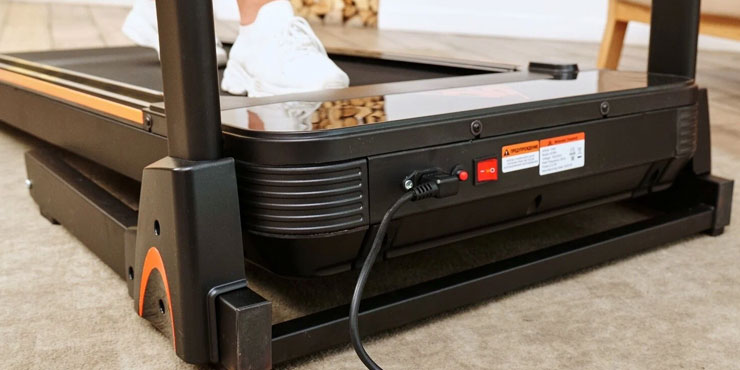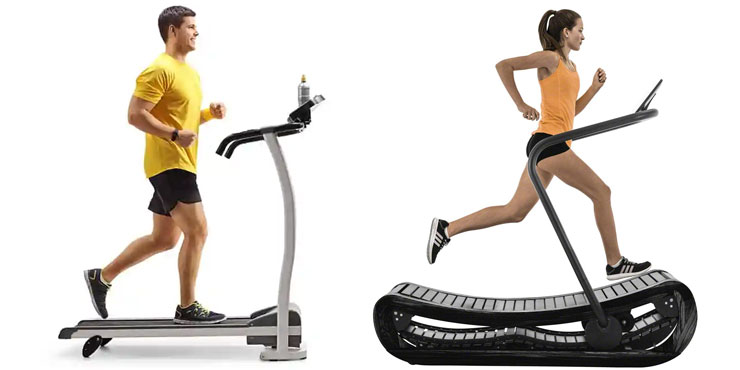How Much Electricity Does a Treadmill Use?
Going for a run outside is a great way to get your daily exercise. But when the weather doesn’t cooperate, many people turn to treadmills for their cardio workouts. Treadmills provide a convenient way to walk, jog or run without leaving your home. But keeping a treadmill plugged in all the time comes with an energy cost. So How Much Electricity Does a Treadmill Use?
In this article, we’ll break down the average electricity usage of treadmills. We’ll look at how factors like the treadmill motor size, incline settings, and usage time impact power consumption. You’ll learn how treadmills compare to other common household appliances when it comes to electric costs. We’ll also provide tips for using your treadmill more efficiently. That way you can reduce your energy bill while still enjoying the benefits of a home treadmill workout.
Contents
- How does it work?
- Manual Treadmill (No electricity)
- Types of treadmills
- Factors Influencing Treadmill Energy Consumption
- Treadmill Features and Settings:
- User Weight and Intensity of Use:
- Treadmill Age and Condition:
- Which treadmills use the most electricity and why?
- Measuring Treadmill Energy Consumption
- Tips to Reduce Treadmill Energy Consumption
- Outcome
How does it work?
A treadmill uses electricity to power several key functions:
-
Motor – The motor is the biggest electricity draw. It powers the continuous belt movement that allows you to walk or run in place. More powerful motors use more electricity to operate.
-
Incline/Decline Settings – Many treadmills allow you to electronically adjust the incline or decline to simulate walking or running up and down hills. This uses electricity to tilt the deck.
-
Console Display – The console that tracks time, distance, calories burned, heart rate, etc. runs on electricity. Advanced consoles with web browsing and video capability use more power.
-
Fans – Some treadmills have electric fans built into the console to help keep you cool during your workout. These also draw additional power.
-
Controls – The electronic control board, buttons and other electronics that allow you to operate the speed, incline, programs, etc. use electricity.
-
Safety Features – Safety features like automatic stop switches need electricity to function.
-
Connectivity – Features like WiFi, Bluetooth, audio speakers, and ports for charging devices require power.
So in summary, electricity powers the motor, controls, and extra features that make a treadmill an intelligent workout machine rather than just a manual belt. The more features included, the more electricity a treadmill will use.
Manual Treadmill (No electricity)
Here are some examples of popular treadmills that do not require electricity and their pros and cons:
- AssaultRunner Elite – This manual treadmill doesn’t need to be plugged in, making it very convenient. It can be used anywhere without access to an outlet. However, the lack of a motor means you have to power the belt yourself, so it requires more physical effort than a motorized treadmill. And without electricity, you miss out on features like automatic speed control, inclination settings, and workout tracking.
- Sunny Health & Fitness SF-T1407 – As a self-powered treadmill, this model doesn’t need electricity. You simply walk or run on the belt to move it. The advantage is you can use it anywhere without outlets. Downsides are that you control the speed entirely by your pace, there are no customized workout programs or tracking, and it requires more exertion.
- Primal Strength Curved Treadmill – This non-electric treadmill uses your movement to propel the belt. Benefits are portability and independence from power outlets. But the manual operation means speed and resistance levels are limited. Stats tracking and programmed workouts are not included either.
- NordicTrack Commercial X22i – Although motorized, this treadmill can switch to manual mode and operate without power. This gives you the flexibility to use electricity for motor assistance or go cordless. However, stats tracking and controls are limited in manual mode.
Manual treadmills offer a way to walk or jog in place without the use of a motor or electricity. Unlike their powered counterparts, these non-motorized machines rely solely on your own leg strength to move the belt and simulate running. While this makes them an extremely simple and affordable exercise option, manual treadmills have significant limitations.
Because your pace determines the speed of the belt, it’s difficult to do interval or sprint workouts. There’s also no way to electronically adjust the incline or resistance levels. Without a console, you also miss out on important workout metrics and programmed training options.
Ultimately, while manual treadmills save you from worrying about outlets and electricity, their bare-bones designs mean you sacrifice the advanced performance tracking, customized workouts, and motorized operation that people expect from modern treadmills. These limitations relegate non-powered models to basic walking and light jogging.
Types of treadmills
Treadmills come in various types, each with different power requirements and energy consumption. Below is a summary table describing different types of treadmills and their general comments on electricity consumption:
| Type of Treadmill | Electricity Consumption | General Comments |
|---|---|---|
| Manual Treadmill | None (human-powered) | Does not consume electricity; eco-friendly option. |
| Motorized Folding | 600-900 watts per hour | Moderate energy use; convenient for home use. |
| Motorized Non-Folding | 800-1500 watts per hour | Higher energy use; suitable for gym settings. |
| Commercial Treadmill | 1500-3000 watts per hour | Highest energy use; ideal for heavy-duty use. |
| Hybrid Treadmill | Varies depending on mode | Uses less electricity when used in manual mode. |
| Under-Desk Treadmill | 200-500 watts per hour | Low energy consumption; designed for office use. |
-
Manual Treadmill: These treadmills do not consume electricity since they are powered by the user's walking or running motion. They are environmentally friendly but may require more effort to use.
-
Motorized Folding: These treadmills are common in home settings and consume moderate electricity. They are convenient for users who have limited space.
-
Motorized Non-Folding: Typically found in gyms, these treadmills have a higher electricity consumption rate due to their continuous use in busy environments.
-
Commercial Treadmill: Designed for high-intensity usage in commercial gyms, these treadmills consume the most electricity. They are built to withstand heavy traffic and provide advanced features.
-
Hybrid Treadmill: The electricity consumption of hybrid treadmills varies depending on the mode (manual or motorized). When used in manual mode, they consume little to no electricity, making them energy-efficient.
-
Under-Desk Treadmill: These compact treadmills are designed for office use and consume relatively low amounts of electricity. They allow users to stay active while working at a desk.
It's important to note that the exact electricity consumption can vary based on factors such as the treadmill's brand, model, motor efficiency, and usage intensity. Regular maintenance and using energy-saving features can also impact electricity consumption. To minimize energy use, consider choosing a treadmill that suits your specific needs and energy efficiency preferences.
Factors Influencing Treadmill Energy Consumption
Let’s look at what factors influence the increase in electricity consumption when using treadmills.
Treadmill Features and Settings:
-
Incline Settings:
- Higher Incline: Running or walking at an incline requires more motor power, increasing energy consumption.
- Lower Incline: Flatter settings consume less energy as the motor doesn't need to work as hard.
-
Speed Settings:
- Higher Speed: Running at faster speeds demands more motor power and therefore consumes more electricity.
- Lower Speed: Walking or jogging at slower speeds results in reduced energy consumption.
-
Built-in Programs:
- Treadmills often come with pre-set workout programs that vary in intensity and duration.
- Programs with frequent speed and incline changes may use more electricity due to motor adjustments.
User Weight and Intensity of Use:
- User Weight: Heavier individuals put more strain on the motor, leading to higher energy consumption compared to lighter users.
- Intensity of Use: Frequent, prolonged, or high-intensity workouts may result in increased electricity usage due to sustained motor operation.
Treadmill Age and Condition:
- Treadmill Age: Older treadmills may have less energy-efficient motors and components, leading to higher energy consumption.
- Maintenance: Regular maintenance, such as lubricating the belt and checking for wear and tear, can help optimize motor efficiency and reduce energy waste.
Overall, treadmill energy consumption is influenced by a combination of user behavior, machine settings, and the treadmill's age and condition. To minimize energy use, users can adjust settings to match their fitness goals and consider factors like user weight and workout intensity. Additionally, proper maintenance and periodic servicing can help ensure the treadmill operates efficiently and conserves energy over its lifespan.
Which treadmills use the most electricity and why?
There are a few factors that determine how much electricity a treadmill uses:
-
Motor size – Treadmills with larger, more powerful motors will use more electricity than those with smaller motors. Larger motors are needed for treadmills meant for running vs. walking.
-
Incline/decline capability – Treadmills that can simulate inclines and declines use more electricity than basic flat treadmills. Raising and lowering the deck requires more power.
-
Console features – Treadmills with large consoles with features like web browsing or video streaming will use more power than basic consoles. The extra electronics draw more energy.
-
Belt size – Larger belt sizes require more power to move. So treadmills meant for multiple users or running will use more electricity.
Some examples of treadmills that tend to use more electricity:
-
Commercial treadmills – Meant for gyms and high traffic, they have powerful 3-5 HP motors and advanced features.
-
High-end models – Like the Peloton Tread or NordicTrack Commercial 2950, which have large touchscreen consoles and decline/incline.
-
Treadmills meant for running – They have long belts, powerful motors and cushioning for running. Like the Sole F85 or LifeSpan TR1200i.
So in general, the more powerful, featured-packed and sturdier a treadmill is, the more electricity it will draw. Smaller, budget models tend to use less power.
Measuring Treadmill Energy Consumption
Let’s look at the detailed measurement of treadmill energy consumption, influencing factors and calculation formulas.
A. Wattage and Power Rating:
-
Wattage:
- Wattage is a measure of the treadmill's electrical power consumption during operation. It is typically specified in watts (W) or horsepower (HP).
- To find the wattage, look for a label on the treadmill that provides this information. It may also be mentioned in the user manual or on the manufacturer's website.
- For example, if your treadmill has a power rating of 800 watts, it consumes 800 watts of electricity when running at its maximum capacity.
-
Power Rating:
- The power rating indicates the treadmill's maximum electrical power draw when in use. It's essential to consider this rating to understand the treadmill's energy demand.
- The power rating can be provided in both watts (W) and horsepower (HP). 1 HP is roughly equivalent to 745.7 watts.
- Example: A treadmill with a 2.0 HP motor has a power rating of approximately 1491.4 watts (2.0 HP x 745.7 W/HP).
B. Calculating Energy Usage:
-
Watt-Hours (Wh):
- To calculate the energy consumption of your treadmill, you need to know its wattage and the time it's in use in hours.
- Use the formula: Energy (Wh) = Power (W) x Time (hours).
- For instance, if your treadmill's wattage is 800 watts, and you use it for 1 hour, the energy consumption is 800 Wh or 0.8 kWh (since 1 kWh = 1,000 Wh).
-
Usage Time:
- Keep track of the time you spend using the treadmill during each workout session. This can vary from one user to another and one session to another.
Suppose you use a treadmill with a power rating of 800 watts for 45 minutes (0.75 hours) per day. To calculate the daily energy consumption:
Energy (Wh) = 800 W x 0.75 hours = 600 Wh
Energy (kWh) = 600 Wh / 1,000 = 0.6 kWh
C. Kilowatt-Hours (kWh):
- Kilowatt-Hours (kWh):
- Kilowatt-hours are a standard unit for measuring electrical energy consumption, especially on your electricity bill.
- 1 kWh is equal to 1,000 Wh.
- When you calculate energy usage in watt-hours (Wh), you can easily convert it to kilowatt-hours (kWh) by dividing by 1,000.
Using the previous example where you calculated a daily energy consumption of 0.6 kWh, if you used the treadmill daily for a month (30 days), your monthly energy consumption would be:
Monthly Energy (kWh) = 0.6 kWh/day x 30 days = 18 kWh
Understanding these parameters and performing energy consumption calculations helps you assess the cost and environmental impact of using your treadmill. It also allows you to make informed decisions about usage patterns and energy conservation.
Tips to Reduce Treadmill Energy Consumption
Reducing the energy consumption of a treadmill can help lower your electricity bills and minimize your environmental impact. Here are some tips to make your treadmill usage more energy-efficient:
- Use Energy-Saving Features: Many modern treadmills come with energy-saving features like “Quick Start” modes or sleep modes. Utilize these features to reduce idle power consumption when the treadmill is not in use.
- Adjust Speed and Incline Wisely: Running or walking at lower speeds and inclines consumes less energy. Start with a slower pace and gradually increase it to find a comfortable workout intensity that doesn’t strain the motor.
- Opt for Manual Mode: If your treadmill offers a manual mode, consider using it instead of relying on the motor. In manual mode, the treadmill is powered by your movement, saving electricity.
- Turn Off the Display: Treadmills often come with large LED or LCD displays. These displays can consume a significant amount of energy. If you don’t need the display for tracking your workout, consider turning it off during your session.
- Unplug When Not in Use: Even when not in use, treadmills in standby mode may continue to consume small amounts of electricity. To completely cut off power, unplug the treadmill or use a power strip with an on/off switch to disconnect it from the power source.
- Regular Maintenance: Keep your treadmill well-maintained. Lubricate the belt, check for loose or worn parts, and ensure the treadmill is running smoothly. A well-maintained treadmill operates more efficiently.
- Use a Fan: Instead of relying on the treadmill’s built-in fan for cooling, consider using a separate, energy-efficient fan to keep yourself cool during workouts. This can reduce the overall energy consumption of the treadmill.
- Program Your Workouts Efficiently: If your treadmill offers built-in workout programs, choose those that emphasize energy efficiency, such as fat-burning or endurance programs with varying speeds and inclines.
- Workout During Off-Peak Hours: If your electricity rates vary throughout the day, consider using the treadmill during off-peak hours when electricity is cheaper. Many utility companies offer time-of-use pricing.
- Consider Eco-Friendly Treadmills: Explore treadmills that are designed with energy efficiency in mind. Some models are explicitly marketed as eco-friendly and consume less power.
- Multi-Task: Make the most of your treadmill time by combining it with other activities. For example, you can listen to audiobooks, podcasts, or watch educational videos to maximize productivity and reduce the need for additional energy consumption.
By implementing these tips, you can reduce the energy consumption of your treadmill and minimize its impact on both your electricity bills and the environment.
Outcome
In conclusion, understanding how much electricity a treadmill uses is not only practical for managing your energy consumption but also for making informed choices about your fitness routines. While the exact energy consumption varies among treadmill models and user habits, we’ve explored key factors that influence it, such as motor power, speed, and usage patterns.
By implementing energy-saving practices like adjusting speed and incline wisely, utilizing energy-efficient features, and considering user-powered treadmills, you can reduce the environmental impact and lower your electricity bills while staying committed to your fitness goals. Remember that being mindful of energy consumption benefits both your wallet and the planet. So, as you embark on your fitness journey, you can also contribute to a greener, more sustainable future.










